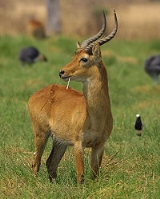
Puku
Encyclopedia
The Puku is an antelope
found in wet grasslands in southern Democratic Republic of Congo, in Namibia
and in Zambia
.
Puku stand about 80 centimetres at the shoulder and weigh from 70 to 80 kilograms. Puku are sandy brown in colour, the underbelly is a slightly lighter brown. Their coat is rougher than the similar-sized Southern Reedbuck
, Lechwe
or Impala
, or the smaller Oribi
. Males have around 50 centimetre long ridge structured horns which are very vaguely lyre
-shaped.
Puku are found almost exclusively in marsh
y grassland and dambos where they eat grass
. Puku are crepuscular
, they are active in the early morning and late afternoon. When scared, Puku repeat a shrill whistle sound. Females gather in herd
s of up to twenty individuals. During the rainy season many herds will come together for added safety, typically reaching around fifty females. Males hold territories
and attempt to persuade herds of females to stay within their territories for as long as possible.
Antelope
Antelope is a term referring to many even-toed ungulate species indigenous to various regions in Africa and Eurasia. Antelopes comprise a miscellaneous group within the family Bovidae, encompassing those old-world species that are neither cattle, sheep, buffalo, bison, nor goats...
found in wet grasslands in southern Democratic Republic of Congo, in Namibia
Namibia
Namibia, officially the Republic of Namibia , is a country in southern Africa whose western border is the Atlantic Ocean. It shares land borders with Angola and Zambia to the north, Botswana to the east and South Africa to the south and east. It gained independence from South Africa on 21 March...
and in Zambia
Zambia
Zambia , officially the Republic of Zambia, is a landlocked country in Southern Africa. The neighbouring countries are the Democratic Republic of the Congo to the north, Tanzania to the north-east, Malawi to the east, Mozambique, Zimbabwe, Botswana and Namibia to the south, and Angola to the west....
.
Puku stand about 80 centimetres at the shoulder and weigh from 70 to 80 kilograms. Puku are sandy brown in colour, the underbelly is a slightly lighter brown. Their coat is rougher than the similar-sized Southern Reedbuck
Southern Reedbuck
The Southern Reedbuck, Rietbok or Common Reedbuck is a diurnal antelope typically found in southern Africa.It was first described by Pieter Boddaert, a Dutch physician and naturalist, in 1785...
, Lechwe
Lechwe
The Lechwe, or Southern Lechwe, is an antelope found in Botswana, Zambia, south-eastern Democratic Republic of the Congo, north-eastern Namibia, and eastern Angola, especially in the Okavango Delta, Kafue Flats and Bangweulu Swamps....
or Impala
Impala
An impala is a medium-sized African antelope. The name impala comes from the Zulu language meaning "gazelle"...
, or the smaller Oribi
Oribi
Oribi are graceful slender-legged, long-necked small antelope found in grassland almost throughout Sub-Saharan Africa.-Description:...
. Males have around 50 centimetre long ridge structured horns which are very vaguely lyre
Lyre
The lyre is a stringed musical instrument known for its use in Greek classical antiquity and later. The word comes from the Greek "λύρα" and the earliest reference to the word is the Mycenaean Greek ru-ra-ta-e, meaning "lyrists", written in Linear B syllabic script...
-shaped.
Puku are found almost exclusively in marsh
Marsh
In geography, a marsh, or morass, is a type of wetland that is subject to frequent or continuous flood. Typically the water is shallow and features grasses, rushes, reeds, typhas, sedges, other herbaceous plants, and moss....
y grassland and dambos where they eat grass
Grass
Grasses, or more technically graminoids, are monocotyledonous, usually herbaceous plants with narrow leaves growing from the base. They include the "true grasses", of the Poaceae family, as well as the sedges and the rushes . The true grasses include cereals, bamboo and the grasses of lawns ...
. Puku are crepuscular
Crepuscular
Crepuscular animals are those that are active primarily during twilight, that is during dawn and dusk. The word is derived from the Latin word crepusculum, meaning "twilight." Crepuscular is, thus, in contrast with diurnal and nocturnal behavior. Crepuscular animals may also be active on a bright...
, they are active in the early morning and late afternoon. When scared, Puku repeat a shrill whistle sound. Females gather in herd
Herd
Herd refers to a social grouping of certain animals of the same species, either wild or domestic, and also to the form of collective animal behavior associated with this or as a verb, to herd, to its control by another species such as humans or dogs.The term herd is generally applied to mammals,...
s of up to twenty individuals. During the rainy season many herds will come together for added safety, typically reaching around fifty females. Males hold territories
Territory (animal)
In ethology the term territory refers to any sociographical area that an animal of a particular species consistently defends against conspecifics...
and attempt to persuade herds of females to stay within their territories for as long as possible.

